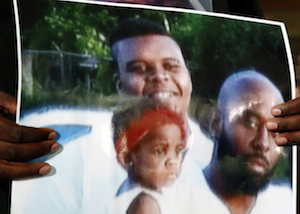WASHINGTON -- Attorney General Eric Holder this week will launch a broad civil-rights investigation of the police department in Ferguson, Mo., two federal law enforcement officials said.
The investigation, which could be announced as early as this afternoon, will be conducted by the Justice Department's civil-rights division and follow a process similar to that used to investigate complaints of profiling and the use of excessive force in other police departments across the country, the officials said.
The move follows the shooting last month of Michael Brown, a black 18-year-old, by a white Ferguson police officer who claimed he acted in self-defense. Brown, who was unarmed, was shot at least six times on the afternoon of Aug. 9. The shooting set off days of often violent clashes between police and demonstrators in the streets of the St. Louis suburb.
The federal officials said the probe will look not only at Ferguson but also at other police departments in St. Louis County. Some, like Ferguson, are predominantly white departments serving majority-black communities, and at least one department invited the Justice Department to look at its practices. The officials spoke on the condition of anonymity to discuss the pending inquiry.
The number of police department reviews the Justice Department has initiated under Holder for possible constitutional violations is twice that of any of his predecessors. At least 34 other departments are under investigation for alleged civil rights violations.
The new investigation is in addition to a Justice Department probe into whether officer Darren Wilson, who fired the fatal shots, violated Brown's civil rights. The new probe will look more broadly at whether the department employed policies and practices that resulted in a pattern of civil-rights violations.
A St. Louis County grand jury also is hearing evidence that could lead to charges against Wilson.
Brown was stopped by Wilson in Ferguson as he walked down the middle of a neighborhood street with a friend. Wilson told investigators that Brown reached for his gun while they had a scuffle at his car, law enforcement authorities said.
Community witnesses say Brown was assassinated in the street. They say he had run from the officer after an argument at the policeman's car, then turned around to surrender after being shot at and being frightened. The six shots all appeared to enter his body from the front, including two in his head, according to an independent autopsy.
Justice Department spokesman Brian Fallon could not be reached for comment. Calls to Ferguson Mayor James Knowles and emails to the Ferguson Police Department's public relations firm were not immediately returned.
News of the expanded probe came as Missouri Gov. Jay Nixon lifted the state of emergency he declared Aug. 16 in response to looting and violent protesting in Ferguson.
In lifting the declaration, Nixon cited a return to some normalcy in the St. Louis suburb, with school back in session and businesses reopening. He called the progress "a testament to the efforts of community and faith leaders" who worked with government and police officials to return peace to the streets.
His decision means the Highway Patrol is no longer in charge of security in Ferguson. Nixon also terminated an executive order that had activated the Missouri National Guard.
Information for this article was contributed by Sari Horwitz, Carol D. Leonnig, Kimberly Kindy, Julie Tate, Wesley Lowery and Alice Crites of The Washington Post and by staff members of The Associated Press.
A Section on 09/04/2014

